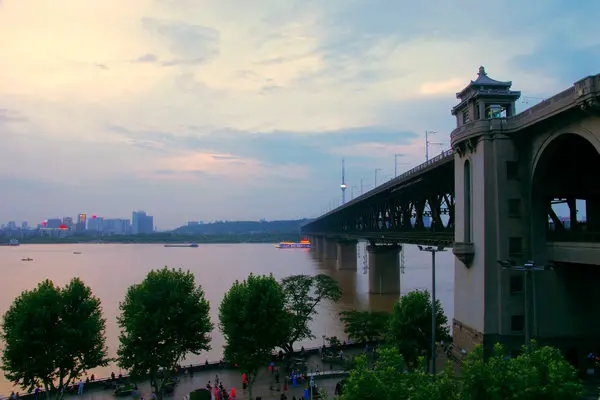The monument at the Wuhan Yangtze River Bridge is carved with the names of 28 experts from the former Soviet Union. Konstantin Silin's is first.
On Oct 15, 1957, the 1,670meter bridge - the first over the river - opened for traffic after 25 months of construction. It was completed two years earlier than planned.
The project time was cut by half thanks to a new method used for the bridge's foundation, which was suggested by Silin, the chief engineer and bridge expert sent by the Soviet Union in the summer of 1954.
It was the third time that Silin was sent to China to help the country to fix crumbling bridges and to build new ones.
Mao Zedong praised the bridge in one of his poems: "A bridge will fly to span the north and south, turning a deep chasm into a thoroughfare."
In 1948, the People's Liberation Army in Northeast China was hampered by damaged bridges when trying to transport supplies.
Silin was then sent to China by the Soviet Union to help to build the Second Songhua River Bridge.
With the bridge completed, the army went across the river and liberated the whole northeast.
In 1949, Silin came to China again as a consultant to the Railways Ministry (now the National Railway Administration). He worked on the construction of bridges in Chengdu and Chongqing and the west section of the Longhai and LanzhoutoXinjiang railways.
After returning home in November 1957, Silin worked to build and sustain friendship between China and his native land.
Konstantin Silin's gravestone features the image of the Wuhan Yangtze River Bridge.
He died in 1996, and the image of the Wuhan Yangtze River Bridge was carved on his gravestone.
"My parents traveled around China together to fix broken bridges, even when they were expecting me," says Elena Silina, Silin's daughter.
She recently came to Beijing to attend the Belt and Road Forum for International Cooperation as an expert representative from Russia.
Silina is a professor of the engineering ecology and technological safety department at the Moscow State University of Railway Transport.
"My father's participation in the construction of the Wuhan Yangtze River Bridge was a very important thing for our whole family," she says.
On the walls of their home were many photos of the bridge and Chinese artworks. Family members used chopsticks.
They'd occasionally go to Chinese restaurants to celebrate, says Silina.
Konstantin Silin in Wuhan in the 1950s.
When Silina's daughter, Ekaterina Fortygina, wanted to study a foreign language in college, Silin strongly suggested Chinese. She agreed.
"My daughter is in China to study. She knows a lot about China, speaks fluent Chinese and she's good at cooking Chinese dishes," Silina says.
While giving keychains with matryoshka dolls as presents to her Chinese friends, Silina was on the lookout for candied hawthorns in Beijing for her grandchildren in Russia, who love the sweetandsour flavor very much, she says.
In 1954, 4yearold Elena came to live in Beijing with her parents for eight years. She returned in the 1980s and in 2000. Each time, she was surprised to see how much Beijing had changed over the years.
"China has grown fast, and many of its techniques in building roads and railways have been introduced to other countries," she says.
Konstantin Silin's daughter, Elena, with her Chinese friends in Beijing in the 1950s.
Liu Changyuan, deputy chief engineer of the Wuhan Yangtze River Bridge project, said in a previous interview that "Silin was not only a respected expert but also a very good person".
Liu joined the team building the pillars of the bridge in 1955 as a fresh university graduate.
He recalled that Silin often took a speedboat to examine the pillars and exchanged ideas with construction workers. Liu got to know him during that time.
"He was very modest. He respected us Chinese engineers and workers, and passed on his experience to us," Liu says.
Silin took great pride in the first bridge over the Yangtze River. He often returned to China to visit the bridge.
Once, when he was over 80 years old, he visited the construction site of the Second Wuhan Yangtze River Bridge. After learning about the construction and technique, he told Chinese engineers, including Liu: "I was your teacher when we built the Wuhan Yangtze River Bridge, but now you have become my teacher."
(CHINA DAILY)
 简体中文
简体中文

